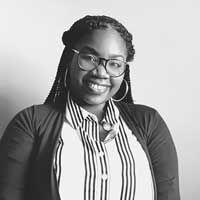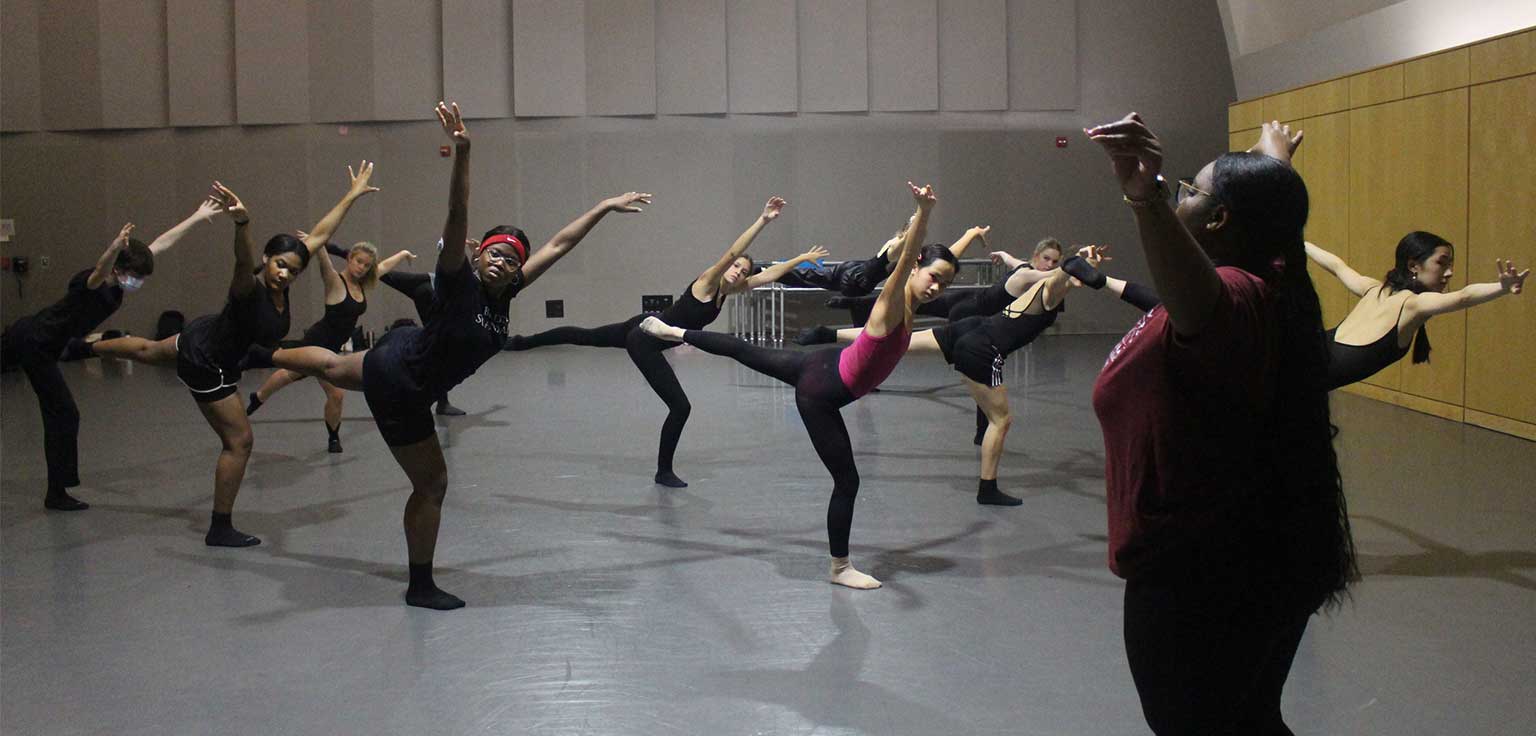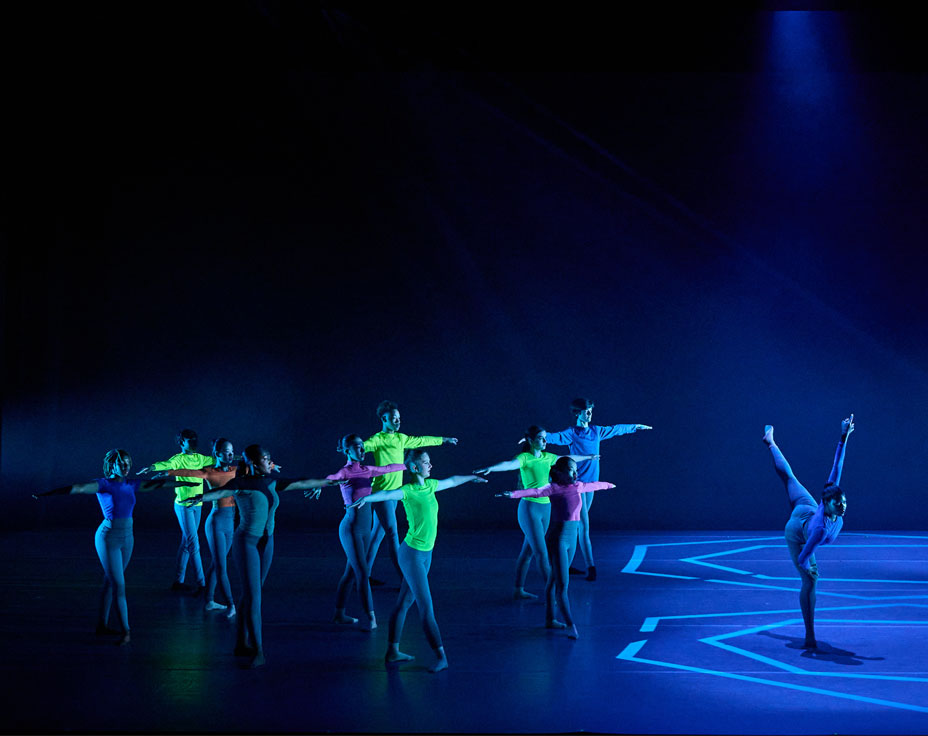COCA’s Choreographic Lab returns to the stage next week, November 4 at 7:00PM, and will showcase new work by choreographer Ryadah Heiskell. The performance presents the culmination of Ryadah’s Choreographic Lab experience at COCA.
Ryadah is the second choreographer to participate in COCA’s Choreographic Lab, a program launched by Antonio Douthit-Boyd and Kirven Douthit-Boyd in 2021 that focuses on developing the choreographic and teaching practices of emerging artists. Ryadah’s six-week experience includes joining COCA’s faculty to teach classes and setting original choreography for one of COCA’s Pre-Professional Division dance companies, COCAdance. Her mentors for the Choreographic Lab include Anthony Burrell, Tommie-Waheed Evans, Nina Flagg, and Clarice Young.
Hear from Ryadah about her new work for Choreographic Lab and details of her experience:
Tell us about the works you’re creating for COCA’s student company, COCAdance.
The piece I’m creating for COCAdance is called Inertia. Inertia is the tendency for an object (or person) to remain unchanged unless acted upon by an outside force. For this piece, I’d like to explore that concept, both, in the way the term is used in physics, as well as in psychology. With this in mind, I started creating the piece based on a series of ideas & questions, in no particular order:
- How one object’s movement/stillness affects another, or a group
- Impact of observing vs. participating; does this change the experience?
- Desire vs. apathy, does it matter? (i.e. “I want to move but can’t.” vs. “I don’t care if I move or not.”)
- Does distance from impact matter? If there’s a group, does the experience of the “object” that receives the initial impact differ from one at the back of the group?
Because I’m approaching the concept from both a physical and psychological lens, I think it inherently became social commentary. The piece is still abstract, as there is not a super defined story line, but you can see clear interactions between the dancers, where a deeper story can be inferred. While there are no “characters,” some dancers represent very specific types of energy, which can be interpreted in a number of ways, depending on your own background and experiences.
Throughout the lab experience, you’re receiving mentoring from world-renowned dancers. Tell us what these mentoring sessions have been like for you and how they have helped you as you’re creating new work.
The mentoring I have received during this experience has been amazing! Each mentor has offered a different perspective but they all have been extremely supportive and encouraging. From helping me brainstorm ideas on how to approach specific parts of the piece, or things I’m trying to convey, to posing questions to help me dig deeper into, not only the concept for the piece, but also what I want as a choreographer. They have been so kind and open with their time, their expertise, and support, even beyond the scheduled times for us to talk. Kirven and Antonio did a phenomenal job of matching me with mentors who could speak to nuanced parts of my experience as a creative and choreographer, which has truly been invaluable. Since my work combines different styles, in the past, sometimes the feedback I would receive was through such a different lens that it was hard to apply it, or it would just feel like my work was being forced into a box that truly just didn’t fit. With the mentorship I’ve received during the Choreographic Lab, my experiences and choreographic style have not only been validated, but encouraged, supported, and enriched. I truly could not have asked for a better mentorship experience.
What have you gained from this experience?
Aside from what’s mentioned above, if I were to summarize it simply, I’d say I have gained freedom and confidence. To elaborate, the creative freedom that Antonio and Kirven have provided with this experience, has allowed me to apply that to my other creative and choreographic endeavors. Thus, increasing my confidence in my ideas and being able to allow myself the freedom to push past my own limits.
What has been the most memorable moment?
There honestly have been so many significant moments throughout this process that it’s hard to choose just one. However, I think the one that will stick with me the most is one I had in rehearsal with the dancers, and I don’t even think they realized how significant it was. It was about four weeks into the process and I hadn’t settled on the song for the final section yet. To be clear, I had considered this song at the very beginning of the process but was second guessing myself. It was at the point where I needed to start finalizing things. I still wasn’t sure about it, because the song was pretty different from songs I’ve used for this type of piece before, and again, my own self-imposed limits, but I thought I’d at least just try it. I gave the dancers some choreography, chose a random part in the song, and let them try it. Right after they tried it with the music for the first time, the energy in the room completely changed. Up until that point they had mostly been more serious and a bit reserved during the rehearsal process, which as an instructor, is great! However, what I valued most about that moment, is that I started to see them open up and just have fun with the choreography. Instead of just standing still and waiting for the cue, they were bouncing with the music and vibing together. They were genuinely just having fun. It was such a significant moment for me that served as confirmation that I was going in the right direction and my original instinct to use that song was right. We actually kept that choreography and timing for the piece. It’s the part where they first come together toward the end of the last section.
What has COCA meant to you?
Since coming to St. Louis for school, I’ve always known COCA to be a pillar in the St. Louis arts community. COCA has, inadvertently, represented opportunity and potential to me. Anyone I know who took classes, taught, was involved in a show, or anything else at COCA, has left the experience with more opportunities than they started with. From what I’ve seen, the people who run any of the programming at COCA have the specific ability to recognize potential and turn it into opportunity. Whether it’s an opportunity to fine tune technique, perform, teach, or whatever else, people who participate in anything COCA offers, leave the experience better for it and this is exactly what I’m experiencing with the Choreographic Lab. It has been an amazing and enlightening experience where I have been able to push myself and my potential as an artist. I feel that this has been such a unique opportunity to explore creatively and showcase my choreography to a whole new audience. It has helped build my confidence to pursue more unique choreographic opportunities in the future.
What’s next for you?
Well, I still have some other choreographic endeavors that I’m already working on this year but I hope to have more to add to the list. Right before the start of the pandemic, I was preparing to put together my own show, but obviously, those plans changed. Since then, my life got really busy so I never revisited the idea. I think I’d like to do that now. So that may be next! Some people have suggested that I start my own company. Knowing the amount of work (and money) required to do that, I don’t think it’s something I could do very soon, though I do want to at least start looking into what that would look like. I eventually want to be in a position to create opportunities for other dancers and choreographers in the community like COCA, and specifically, Kirven and Antonio have done for me and so many others. I can’t say exactly what that will look like, but that is my ultimate goal.

About Ryadah Heiskell
Ryadah Heiskell has been choreographing since 2012 for recreational, competition, and concert dance. Heiskell’s choreography combines jazz, modern, contemporary, and hip-hop dance styles to create unique, entertaining works. Her approach to choreography involves exploring time/space dynamics based in musicality, specifically polyrhythms, and the manipulation of traditional technique to create unique steps & moments throughout the piece. While Heiskell is inspired directly by the music, her goal is always to highlight the skills of the dancers. Most of Heiskell’s concert dance work explores abstract concepts in the human experience.

